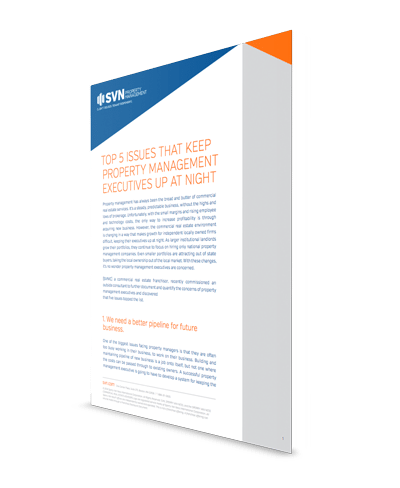It’s Almost 2016…
Which Means It’s Time to Start Planning!
If you were at SVN, you’d hear me present my tactical business planning call. And you’d hear our CEO, Kevin Maggiacomo, teach you how to do a strategic plan in 60 minutes.
I love business plans and I think they’re important. When I brokered, I created one, reviewed it at least once a week, stuck to it and measured results quarterly.
In fact, that’s the secret to having a business plan. It isn’t that you have it. It’s that you stick to it and measure your ability to stick to it. That’s hard to do. I know. You’re busy. Sometimes you get lost doing deals. And you might even forget about your business plan.
If this sounds like you, don’t worry. I’m going to make it easy on you. Go ahead and print this email out, because you’re going to fill in some blanks. Do it now. We’ll wait.
Welcome back! Now, please write what you need more of in 2016 here:
- ________________________
Now, write what you need to do to get it:
- ____________________________
For instance, you might have written “more closings” on line 1 and “more listings” on line 2.
Go back and add some numbers to what you wrote (or print this out again). For instance, you might want “8 more closings” and “11 more listings.” Now put them together as follows:
To get the (1)_____________ I need, I will do/take (2)_______________.
For instance: To get the 8 more closings I need, I will take 11 more listings.
Now, run that one-sentence business plan by someone that you can count on – like a coach or your Managing Director. He or she can help you make sure that the goal is a reasonable one and that it can actually help you move your business forward.
Once you get it blessed, execute on it.
Here’s what I mean by “execute on it.” Every day, first thing in the morning, look at that goal and think about it. Then, do tasks that directly relate to that goal first and spend as much time as possible on those tasks – at least half of your day. It’s that simple.
In a perfect world, you’d be at SVN and you’d create a big-picture strategic plan with Kevin. You’d also create a nuts-and-bolts tactical plan with me. And you’d create a one-sentence must-do goal. All three working in concert — with you at SVN — will give you the best results in 2016.
But, at a minimum, I know that you can do – and stick to – this super-simple one sentence business plan.
To your success in 2016!
See you in San Diego at the conference!


 Looking for more examples? Have you ever noticed that most neighborhood centers have a card store right near the supermarket? Or, for that matter, have you ever wondered why neighborhood centers typically have take-out focused restaurants like Chinese or pizza shops near the supermarket? It’s all about convenience.
Looking for more examples? Have you ever noticed that most neighborhood centers have a card store right near the supermarket? Or, for that matter, have you ever wondered why neighborhood centers typically have take-out focused restaurants like Chinese or pizza shops near the supermarket? It’s all about convenience.
 Many of you are reading this and thinking that this isn’t a challenge. After all, you talk to 10, 20, 30 people every day, right? As I write this, it isn’t even
Many of you are reading this and thinking that this isn’t a challenge. After all, you talk to 10, 20, 30 people every day, right? As I write this, it isn’t even 


 One of the most disruptive things in commercial real estate is new development. Just about any new project, other than the smallest and most inconspicuous new buildings, in an area can change everything. At times, it can help and at other times it can hurt. Don’t worry, though…. With good strategy, you can turn someone else’s project into a windfall profit!
One of the most disruptive things in commercial real estate is new development. Just about any new project, other than the smallest and most inconspicuous new buildings, in an area can change everything. At times, it can help and at other times it can hurt. Don’t worry, though…. With good strategy, you can turn someone else’s project into a windfall profit!



 advisor who may lack in years in the business, but does not lack in tools, resources and initiative. Note that in commercial real estate, the term “junior” doesn’t necessarily refer to the age of the broker or advisor, but more likely the years in the industry. Many of our own top SVN advisors already had successful careers in completely different industries. Why work with a less experienced advisor? First of all, most established firms are relatively selective about who they recruit, so the odds are that you’ll get someone pretty good. Second of all, that advisor should be desperate to do a good job so that they can build their resume. They will give your deal much more attention than a more experienced advisor will. (We note this also works when selecting attorneys!)
advisor who may lack in years in the business, but does not lack in tools, resources and initiative. Note that in commercial real estate, the term “junior” doesn’t necessarily refer to the age of the broker or advisor, but more likely the years in the industry. Many of our own top SVN advisors already had successful careers in completely different industries. Why work with a less experienced advisor? First of all, most established firms are relatively selective about who they recruit, so the odds are that you’ll get someone pretty good. Second of all, that advisor should be desperate to do a good job so that they can build their resume. They will give your deal much more attention than a more experienced advisor will. (We note this also works when selecting attorneys!)